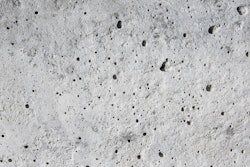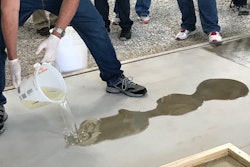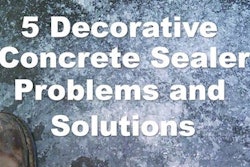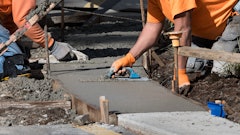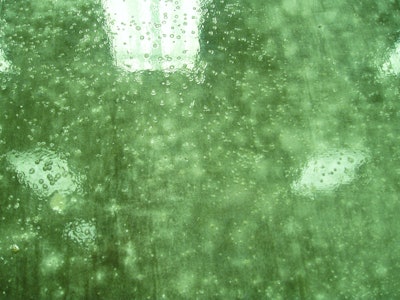
Concrete sealer problems and the associated call-backs are one of the largest sources of frustration for decorative concrete contractors. When a concrete sealer does not look or perform as expected, the cause can usually be traced back to over-application, application in non-ideal conditions, or a build-up of multiple coats. Below are some common sealer issues decorative concrete contractors face, why they happen, and how to avoid them.
Problem: Sealer bubbled
The presence of bubbles or popped bubbles in the sealer a sign of over-application; the sealer was applied too heavily. Sealers should be applied so thinly that they shouldn't be able to physically support bubbles.
Any air displacement from the concrete surface during sealer application should be free to quickly move through the thin, wet sealer film. At a typical coverage rate of 300 square feet per gallon, one coat of an acrylic concrete sealer should be about 5 mils thick when wet. When dry, one coat of sealer is only about 2 mils thick. For comparison, a sheet of copy paper is about 10 mils thick and a credit card is 120 mils thick.
When the sealer is applied too heavily, the air displaced through the surface can't escape, and it forms a bubble in the sealer surface. Concrete sealers are best applied in two thin coats.
The first coat of sealer acts like a primer. Most of it will disappear into the concrete surface, and the concrete will probably look fairly unattractive after the first coat. The second thin coat will provide an even finish, color enhancement and gloss.
It is time consuming to actually measure out 300 square feet of concrete and 1 gallon of sealer in order to ensure the coverage rate as applied follows the manufacturer’s recommendation. It also requires more time and patience to apply two thin coats of sealer instead of one heavy coat.
However, taking these two steps will prevent many sealer issues and avoid callbacks.
Bubbling of a sealer can also occur if application is done in hot weather, or if the concrete is in direct sun. In these conditions, the sealer will “skin over” and dry on the surface before all of the solvent has evaporated. Over time, the pressure of the solvent trying to evaporate will form a bubble in the sealer surface.
Carefully follow the sealer manufacturer’s recommended coverage rate and apply during the coolest part of the day when concrete is not in direct sun. Two thin coats should be applied rather than one heavy coat.
Contractors working in East Coast and Midwestern states are challenged by regulations that prohibit the use of traditional concrete sealers based on xylene or mineral spirits. In these states, sealers must be either water based or formulated with “exempt” solvents that do not contribute to air pollution.
Although exempt solvents keep the air cleaner, sealers based on these solvents dry much faster than traditional solvent based products. For this reason, application of exempt solvent based sealers can be tricky until the contractor has become accustomed to the fast dry time and the changes in application methods that are required. Following the rules regarding application thickness and applying in the proper environmental conditions are even more critical when using these specialty products.
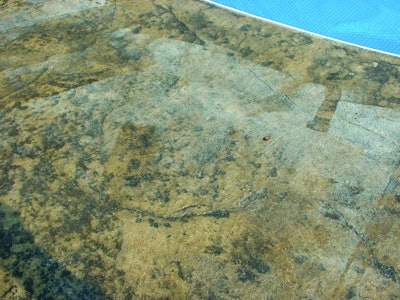 Heavy applications of sealer can lead to moisture entrapment and a white appearance.
Heavy applications of sealer can lead to moisture entrapment and a white appearance.
Problem: Solvent-based sealer turned white, is peeling or is flaking off
There are two key contributors to “blushing”, or whitening of a solvent based concrete sealer. The first is application to a concrete surface that is wet, or to fresh concrete that still contains bleed water.
When this occurs, the sealer will not bond to the concrete surface but will instead float on a trapped film of water. The second cause of sealer blushing is over-application.
Thick coats of sealer, or a buildup of coats applied over the years, will cause moisture to become entrapped under the sealer and, in time, the sealer debonds from the concrete. When this occurs, the sealer itself does not turn white. Instead, the surface only appears white because the trapped moisture and air under the debonded sealer changes its refractive index, making it look white to the human eye.
In time, the sealer will peel or flake off the surface. To avoid this problem, follow the sealer manufacturer’s recommendations regarding coverage rate, number of recommended coats, and preparation of the surface before sealing.
Problem: Water-based sealer is white or powdery
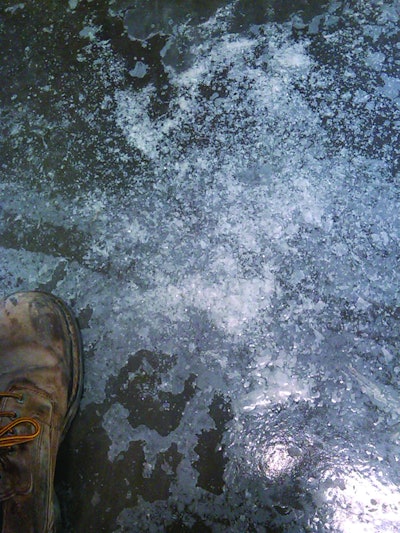 An excessively heavy application of sealer led to blushing followed by complete bond failure.
An excessively heavy application of sealer led to blushing followed by complete bond failure.
Water-based acrylic sealers dry by a process called coalescence, where first the water, and then the coalescing solvent, evaporate and fuse together the acrylic particles, forming the sealer film. If the temperature during application is too low or humidity is too high, the coalescing solvent will evaporate before the water does and the sealer will dry white or powdery because the latex particles did not come together before drying.
Some water-based sealers, even after proper application and drying clear, remain susceptible to blushing when exposed to frequent moisture, such as around pool decks or in areas where water puddles.
Always read the product literature before applying a sealer to become familiar with its limitations, especially when selecting a water-based product. Sealers based on waterborne technology are not easily stripped using conventional solvents and methods.
Problem: Sealer is stained from oil, leaves, tires, fertilizer, etc.
The most common concrete sealers are manufactured with acrylic polymers that do not provide exceptional chemical or stain resistance to the concrete.
For more durability and resistance to chemicals and staining, consider an epoxy or urethane coating system, and ensure that the coating is appropriate for exterior use before applying to outdoor concrete.
Problem: Concrete is dark and/or blotchy after sealer is applied
Film-forming concrete sealers will darken concrete and leave a glossy shine to some extent, giving the concrete a “wet look." The concrete will lighten back to its unsealed color over time, as the sealer wears off or is removed.
Because every concrete slab is unique in its color and texture, the color of concrete after sealer application is difficult to predict. The concrete mix design and use of chemical admixtures, surface finishing techniques and porosity are just a few factors that will affect the color of a concrete surface.
A concrete sealer will deepen the true color of concrete, and will highlight all the differences in the surface texture that result from floating and finishing. Sealers also bring out the “grain” in concrete, just like a varnish does on wood. If changing the concrete color after sealing is a concern, use a penetrating water-repellent sealer or do a small test application of a film-forming sealer to make sure the color change will be acceptable.
Please note that water-based cure and seals are a milky white color as supplied, but will dry clear if applied properly. Water-based sealers do not darken concrete as extensively as solvent-based materials, and the gloss level is lower.
Concrete sealer problems are much easier to prevent than to solve. All of these unfortunate circumstances can be avoided by carefully reading and following the instructions on the sealer technical data page, or by contacting the manufacturer to get assistance before applying the product.




